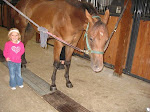
During the winter, most horses will have changes in their nutritional needs. Cold weather, which doesn’t permit riding, can dramatically alter the amount of calories a horse needs to consume. Some simple, general tips can help to keep your horse in great shape over the winter.
Spending more time in the stall and less riding usually means that a horse will need fewer calories. Then again, in colder weather, a horse burns more calories to generate body heat and maintain its normal core temperature. It’s important to know, however, that in all but the most extreme weather, a horse’s caloric needs generally rise only ten to twenty percent.
In the past, horse owners fed corn during the winter to help horses generate more body heat and reduce the stress of cold weather. However, a horse is able to generate more heat in the hindgut from the fermentation of forage, such as hay and grass. Replacing some of the horse’s grain concentrate with hay can help it to more easily maintain its body temperature. We currently stock brome, timothy, and alfalfa that can serve as forage for the horse.
One way to do this is to substitute two pounds of hay for each reduced pound of grain fed daily. When less than half a percent of the horse’s body weight is fed daily in grain, consider supplementing with a premium feed. This ensures that the horse is still receiving the right amounts of vitamins and minerals at the reduced feeding rate. For instance, a good winter ration for a mostly idle horse might be seventeen pounds of quality grass hay and two pounds of premium feed. This combination meets 110% of a mature horse’s caloric needs, as well as ensuring it receives the right protein, mineral, and vitamins. Feed a premium feed such as Life Design Mare and Foal, Prime, Senior, Safechoice, Equine Junior, Senior, or Strategy. Avoid feeding Life Deign Compete and Omolene 200 if the horse is receiving little to no activity, as these feeds are high in protein and could contain too many calories for an idle horse.
When the cold weather begins, horse owners can notice a greater frequency of impaction colic. One of the main causes of impaction colic can be dehydration from reduced water consumption, inadequate water availability, and eating hay (which only contains 10% water) rather than green summer grass, which contains 80% water. Making sure that horses have good access to unlimited warm water can help encourage horses to drink more and prevent impaction colic. When a horse drinks cold water, they must use extra energy to replace the heat lost to the chilling water, and they instinctively drink less. A good add on product for any horse owner would be a stock tank de-icer and/or bucket heater. Adequate water intake ensures that the fiber in the digestive system stays hydrated, which allows it to be broken down by intestinal bacteria. This makes it much less likely to cause blockages. Adding a free-choice mineral supplement or mixing salt, mineral supplements, and electrolytes into a horse’s feed can also simulate a horse to drink more water. We stock horse protein blocks from Manna Pro, salt from Cargill and electrolytes from Farnam. Providing adequate exercise also reduces colic by helping to aid gut motility.
Because an unclipped horse’s winter coat can make it difficult to check the horse’s body condition, the owner should use a weight tape or scale monthly to check the horse’s weight. We stock horse weight tapes from Syrvet. This allows the owner to adjust the feeding program as needed and to keep the horse in peak physical condition and ready for warmer weather.
Finally, pay attention to the barn’s ventilation. Good airflow is even more vital than warmth to horses kept in a closed barn. Also, care should be taken when feeding hay to horses kept in enclosed barns. Horses that are fed hay from nets above their heads have more frequent respiratory problems than horses that eat hay from the ground or from hay nets hung low enough to allow the respiratory tract to drain down. We carry a couple of different hay feeding bags and the Grazor from Double L that can be used to feed hay to your horse. However, be careful not to have the nets hung so low that a horse can get its legs tangled in them.
.jpg)
No comments:
Post a Comment